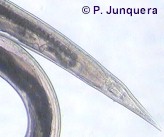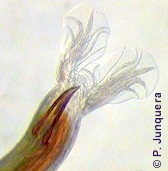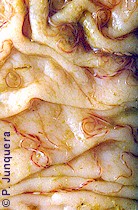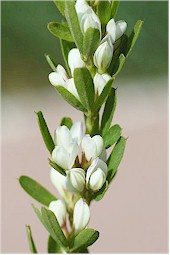Haemonchus is a genus of parasitic roundworms that infects cattle, sheep and goats and other wild ruminants. Worms of this genus are also called barber's pole worms, twisted wireworms or large stomach worms.
that infects cattle, sheep and goats and other wild ruminants. Worms of this genus are also called barber's pole worms, twisted wireworms or large stomach worms.
It is found worldwide but is more frequent and harmful in regions with tropical and subtropical humid climates.
These worms do not affect dogs and cats.
The most relevant species for livestock are:
- Haemonchus contortus infects mainly sheep and goats, but also cattle.
- Haemonchus placei infects mainly cattle, but also sheep and goats.
The disease caused by Haemonchus worms is called haemonchosis.
Is livestock infected with Haemonchus worms contagious for humans?
- NO: The reason is that these worms are not human parasites.
You can find additional information in this site on the general biology of parasitic worms and/or roundworms.
Final location of Haemonchus worms
Predilection site of adult Haemonchus worms is the stomach (abomasum).
Anatomy of Haemonchus worms

Adult Haemonchus worms are 1 to 3 cm long and have a reddish color, whereby females are larger than males. As in other roundworms, the body of Haemonchus worms is covered with a cuticle, which is flexible but rather tough. The cuticle of Haemonchus worms is rather transparent and shows longitudinal striations.
These worms have a tubular digestive system with two openings, the mouth and the rectal opening. The mouth of Haemonchus worms has a dorsal lancet for cutting the host's tissues. They also have a nervous system but no excretory organs and no circulatory system, i.e. neither a heart nor blood vessels.
The female ovaries are large and the uteri end in the female genital opening, which has a characteristic flap in Haemonchus worms. Typical for these worms is that the uteri are wound around the gut. Since the gut is full of blood with a reddish color and the uteri are white, female worms look like small barber's poles. Males have a copulatory bursa with two barbed spicules for attaching to the female during copulation.
The eggs are ovoid, about 45x80 micrometers, have a thin shell and contain 16 to 32 cells (blastomeres).
Life cycle of Haemonchus worms
Haemonchus worms have a direct life cycle, i.e. there are no intermediate hosts involved. Adult females lay eggs in the stomach of the host that are shed with the feces. Once in the environment the eggs release the L1-larvae that complete development to infective L3-larvae in about 4 to 7 days. By moist and warm weather these infective larvae can survive on pasture and remain infective for several months. However they are not very resistant to cold. Infective larvae are able to climb upwards in moist leaves and stems of pasture plants, where they are more likely to be ingested by grazing hosts.
Livestock becomes infected after ingesting infective larvae with pasture. These larvae enter the pit of gastric glands and feed voraciously on blood flowing out of the lesions they cause to the stomach's lining with their mouthparts. Later on they complete development to adult worms and females start producing up to 10'000 eggs daily. L4 larvae can become arrested (dormant, hypobiotic) in the stomach tissues to survive the cold or the dry season. They resume development to adults later on when environmental conditions become more favorable.
Livestock can also become infected indoors through contaminated hey or feed.
The prepatent period (time between infection and first eggs shed) is 19 to 21 days (without dormancy) but can be shorter in animals with a weak immune system. This is a rather short time that allows several generations during one season.
Harm caused by Haemonchus worms, symptoms and diagnosis

are the most damaging gastrointestinal worms for livestock in tropical and subtropical regions, particularly for sheep and goats. Both the larvae and the adults feed on blood and cause a considerable damage to the stomach tissues. While feeding they release anticoagulants to hinder blood clotting. All this causes numerous lesions in the stomach wall, which becomes inrritated (gastritis). Blood loss results in anemia. Other effects of chronic infections are edema, i.e. accumulation of liquid in the abdomen, thorax, and also in the submandibular tissue, which is know as "bottle jaw" and is characteristic of infections with Haemonchus and other gastrointestinal worms. Severe infections can also cause liver damage, weight loss, unthriftiness, diarrhea (mostly dark) and dehydration. Fatalities are not infrequent.
Massive infection of young lambs can be fatal in a few days, without previous symptoms and without previous shedding of eggs in the feces. The reason is that the immature stages are already voracious blood feeders.
Most Haemonchus infections are mixed with other gastrointestinal roundworms (e.g. Cooperia spp, Nematodirus spp, Ostertagia spp, Trichostrongylus spp, etc.) which worsen the damage caused to affected livestock.
Diagnosis is based on the clinical signs and confirmed after detection of characteristic eggs in the feces. However, as already mentioned, lambs can become seriously sick before larvae have completed development to adults, i.e. before the onset of egg production.
Prevention and control of Haemonchus infections
Non-chemical prevention
Preventative measures that reduce the contamination of pastures with infective larvae (e.g. pasture rotation) and reduce the risk the animals become infected are essential to control Haemonchus infections. This is particularly urgent for this parasite because resistance to almost all available anthelmintics is now widespread in many regions. Such preventative measures are the same for all gastrointestinal roundworms and are explained in a specific article in this site (click here). Such measures must be applied for both young and adult livestock, because Haemonchus infections can be fatal for animals of any age.
Systematic and thorough removal of all manure, keeping the facilities dry and additional hygienic measures of animal facilities wil reduces the risk of infection of housed livestock.
Livestock exposed to these worms often develop natural resistance progressively and may recover spontaneously, but only well fed healthy animals, not already weakened animals. Such resistant animals do not become sick if re-infected, but continue shedding eggs that contaminate their environment. Some indigenous livestock breeds may show a high natural resistance to these worms. Unfortunately such breeds are often not the most productive ones and thus not appreciated by most farmers for economic reasons.

Recent studies suggest that Chinese bushclover (Sericea lespedeza = Lespedeza cuneata) in the form of hay, ground plants or pellets fed to livestock can significantly reduce Haemonchus infestations in sheep and goats.
A lot of research has been carried out on vaccines, but so far vry few really effective ones are available against Haemonchus worms. To learn more about vaccines against parasites of livestock and pets click here.
Biological control of Haemonchus worms (i.e. using its natural enemies) is so far not feasible. Learn more about biological control of worms.
You may be interested in an article in this site on medicinal plants against external and internal parasites.
Chemical control
Numerous broad spectrum anthelmintics are effective against adult worms and larvae, e.g. several benzimidazoles (albendazole, febantel, fenbendazole, oxfendazole, etc.), levamisole, as well as several macrocyclic lactones (e.g. abamectin, doramectin, eprinomectin, ivermectin, moxidectin). But not all of them are effective against arrested larvae of Haemonchus. Read the product label carefully to find it out.
A few other narrow-spectrum anthelmintics such as closantel, nitroxinil and tetrahydropyrimidines (e.g. morantel, pyrantel) are effective against adult worms but may not control larvae and other roundworm species that often infect livestock simultaneously with Haemonchus worms. A few organophosphates (e.g. trichlorfon) is also available in some countries for the control of these worms, but must be used with utmost care because it has a very low safety margin.
Numerous commercial products contain mixtures of two or even more active ingredients of different chemical classes. This is done to increase the chance that at least one active ingredient is effective against gastrointestinal worms that have become resistant, or to delay resistance development by those worms that are still susceptible.
Depending on the country most of these anthelmintics are available for oral administration as drenches, feed additives and/or tablets. Levamisole and most macrocyclic lactones are usually also available as injectables. A few active ingredients are also available for livestock as pour-ons and slow-release boluses.
Excepting slow-release boluses, most wormers containing benzimidazoles (e.g. albendazole, febantel, fenbendazole, oxfendazole, etc.), levamisole, tetrahydropyrimidines (e.g. morantel, pyrantel) and other classic anthelmintics kill the worms shortly after treatment and are quickly metabolized and/or excreted within a few hours or days. This means that they have a short residual effect, or no residual effect at all. As a consequence treated animals are cured from worms but do not remain protected against new infections. To ensure that they remain worm-free the animals have to be dewormed periodically, depending on the local epidemiological, ecological and climatic conditions. An exception to this are macrocyclic lactones (e.g. abamectin, doramectin, eprinomectin, ivermectin, moxidectin), that offer several weeks protection against re-infestation, depending on the delivery form and the specific parasite.
BUT. Resistance to many of these anthelmintics is a serious problem in many regions, particularly in sheep and goats, and the problem is increasing and spreading worldwide (see below).
Copper (as copper shavings, copper sulphate, copper oxide) is also capable of reducing infestations with Haemonchus worms.
Resistance of Haemonchus to anthelmintics
Haemonchus resistance to anthelmintics is number one resistance problem with gastrointestinal worms worldwide. Resistance has been reported against almost all anthelmintics available for its control including benzimidazoles, macrocyclic lactones, levamisole, salicylanilides, tetrahydropyrimidines and organophosphates and monepantel. Multiple resistance, i.e. simultaneous resistance to several chemical classes has also been reported in some countries (e.g. Australia, Brazil, etc.). The problem is particularly acute in sheep and goats, but problems in cattle are increasing and spreading.
This means that if an anthelmintic fails to achieve the expected efficacy against Haemonchus worms, there is a high risk that it is due to anthelmintic resistance.
Learn more about parasite resistance and how it develops.
|
Ask your veterinary doctor! If available, follow more specific national or regional recommendations for Haemonchus control. |